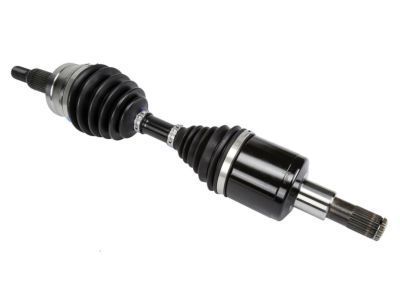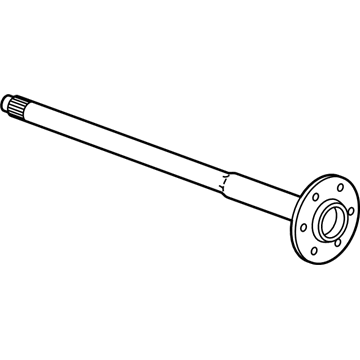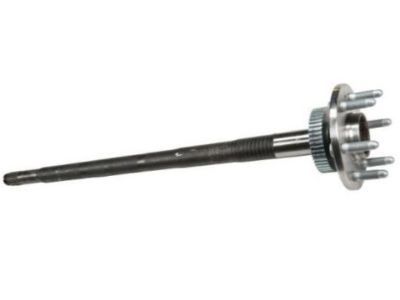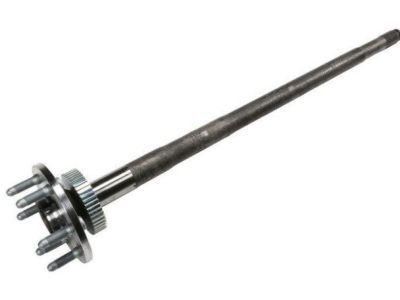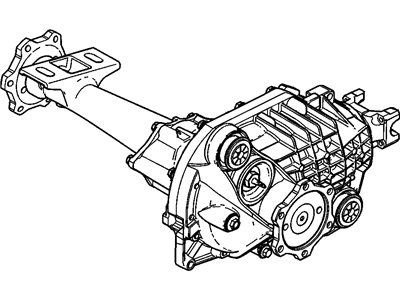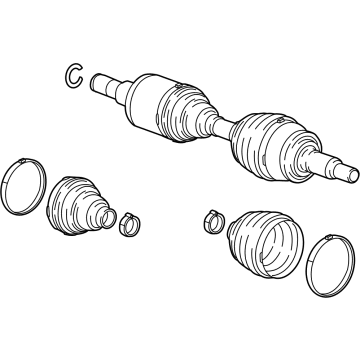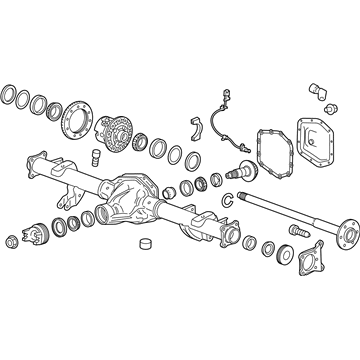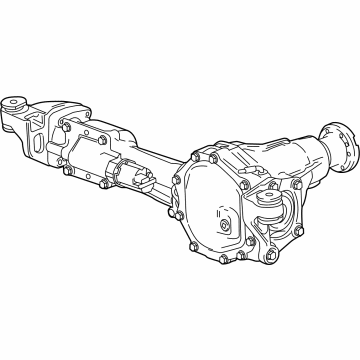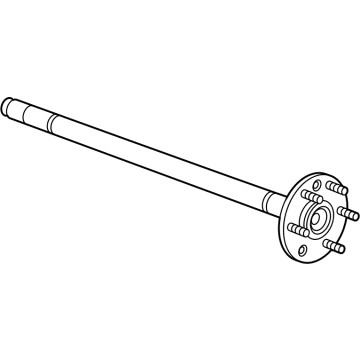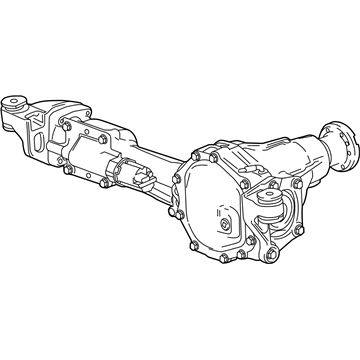
My Garage
My Account
Cart
Genuine GMC Canyon Axle Shaft
Car Axle Shaft- Select Vehicle by Model
- Select Vehicle by VIN
Select Vehicle by Model
orMake
Model
Year
Select Vehicle by VIN
For the most accurate results, select vehicle by your VIN (Vehicle Identification Number).
74 Axle Shafts found
GMC Canyon Front Driver Side Half, Shaft Assembly
Part Number: 84275039$173.03 MSRP: $295.88You Save: $122.85 (42%)GMC Canyon Rear Axle Shaft
Part Number: 23490377$716.11 MSRP: $965.11You Save: $249.00 (26%)Ships in 1-2 Business DaysGMC Canyon Rear Axle Shaft
Part Number: 23490378$693.14 MSRP: $965.10You Save: $271.96 (29%)Ships in 1-2 Business DaysGMC Canyon Front Drive Axle Clutch Shaft
Part Number: 84156082$13.30 MSRP: $22.02You Save: $8.72 (40%)Ships in 1-2 Business DaysGMC Canyon Front Axle Assembly (3.42 Ratio)
Part Number: 25792317$1405.53 MSRP: $2231.53You Save: $826.00 (38%)Ships in 1-3 Business DaysGMC Canyon SHAFT ASM-FRT WHL DRV HALF
Part Number: 84521702$154.55 MSRP: $255.80You Save: $101.25 (40%)Ships in 1-2 Business DaysGMC Canyon Axle Assembly, Rear
Part Number: 84177543$1962.20 MSRP: $2536.79You Save: $574.59 (23%)Ships in 1-3 Business DaysGMC Canyon Rear Axle Assembly
Part Number: 23234089$2692.05 MSRP: $3480.34You Save: $788.29 (23%)Ships in 1-3 Business DaysGMC Canyon SHAFT-FRT DRV AXLE INR
Part Number: 85579602$136.06 MSRP: $216.99You Save: $80.93 (38%)Ships in 1-3 Business DaysGMC Canyon AXLE ASM-FRT
Part Number: 85590234$986.77 MSRP: $1281.52You Save: $294.75 (23%)Ships in 1-2 Business DaysGMC Canyon SHAFT ASM-R/AXL
Part Number: 84937151$127.04 MSRP: $210.27You Save: $83.23 (40%)Ships in 1-2 Business DaysGMC Canyon AXLE ASM-FRT
Part Number: 87821251$1220.24 MSRP: $1584.73You Save: $364.49 (23%)Ships in 1-2 Business DaysGMC Canyon SHAFT-FRT DRV AXLE CLU
Part Number: 84937881$33.51 MSRP: $55.45You Save: $21.94 (40%)Ships in 1-2 Business DaysGMC Canyon SHAFT-FRT DRV AXLE INR
Part Number: 84937888$43.76 MSRP: $72.42You Save: $28.66 (40%)Ships in 1-2 Business DaysGMC Canyon SHAFT ASM-R/AXL
Part Number: 84937152$128.58 MSRP: $212.82You Save: $84.24 (40%)Ships in 1-2 Business Days
| Page 1 of 4 |Next >
1-20 of 74 Results
GMC Canyon Axle Shaft
The Axle Shaft of GMC Canyon is a vital part that divides the torque produced by the differential and transmits it to the drive wheels so that they can rotate independently to increase the friction. These steel shafts are used in different models and can be the solid axles of the trucks and the older RWD cars; the halfshafts are used in cars with independent suspension. SOLID AXLES contain differential and axle and on the other hand SHAFTS transfer power from the transaxle to wheels. Axle shaft can wear out due to contact with obstacles on the road and this cause such problems as noise and vibration and may result to a change in the half shaft due to presence of worn out CV Joints or even torn boots. Altogether, the Axle Shaft is a significant mechanism that helps the GMC Canyon vehicles to carry the weight of the car, transmit power or torque to the wheels, and keep the wheels in a correct position.
Each OEM GMC Canyon Axle Shaft we offer is competitively priced and comes with the assurance of the manufacturer's warranty for the part. Furthermore, we guarantee the speedy delivery of your orders right to your doorstep. Our hassle-free return policy is also in place for your peace of mind.
GMC Canyon Axle Shaft Parts Questions & Experts Answers
- Q: How to remove and install an axle shaft on a 4WD GMC Canyon?A:Loosen the wheel lug nuts, raise the front of the vehicle and support it securely on jackstands. Remove the wheel. Remove the splash shield from under the vehicle. Pry off the hub cover using a hammer and chisel. Remove and discard the axle shaft/hub nut. To prevent the hub from rotating, brace a large prybar across two of the wheel studs or insert a long punch or screwdriver through the window in the brake caliper and into the disc cooling vanes. Disconnect the wheel speed sensor electrical connector and free the harness from its retainers. Unbolt the brake hose retainer where it joins the metal brake line at the frame. Remove the steering knuckle and simultaneously pull the axle shaft stub shaft out of the hub. If the stub shaft sticks in the hub splines, tap on the end of the shaft with a brass punch and a hammer. If that doesn't free the splines, push the axle shaft from the hub with a puller. Drive the inner end of the axle shaft away from the Differential or intermediate shaft with a hammer and brass drift. Place the end of the brass drift against the inner axle shaft joint housing. Apply enough force to disengage the retaining ring on the inner end of the axle shaft from the differential or intermediate shaft. Remove the axle shaft from the differential. Installation is the reverse of removal, with the following additions. Before installing the axle shaft, lubricate the splines on the stub shaft with multi-purpose grease. Install a new axle shaft/hub nut and tighten it to the specific torque value. Tighten the suspension fasteners to the specific torque. Tighten the wheel lug nuts to the specific torque.
Related GMC Canyon Parts
Browse by Year
2024 Axle Shaft 2023 Axle Shaft 2022 Axle Shaft 2021 Axle Shaft 2020 Axle Shaft 2019 Axle Shaft 2018 Axle Shaft 2017 Axle Shaft 2016 Axle Shaft 2015 Axle Shaft 2012 Axle Shaft 2011 Axle Shaft 2010 Axle Shaft 2009 Axle Shaft 2008 Axle Shaft 2007 Axle Shaft 2006 Axle Shaft 2005 Axle Shaft 2004 Axle Shaft
